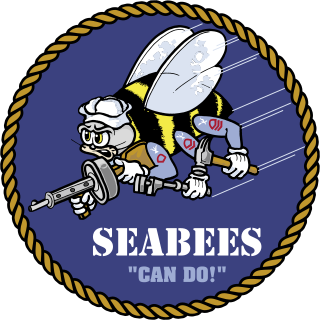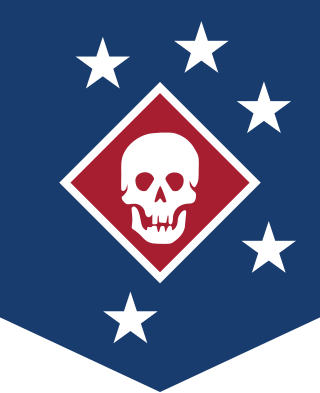
United States Naval Construction Battalions, better known as the Navy Seabees, form the U.S. Naval Construction Forces (NCF). The Seabee nickname is a heterograph of the initial letters "CB" from the words "Construction Battalion". Depending upon context, "Seabee" can refer to all enlisted personnel in the USN's occupational field 7 (OF-7), all personnel in the Naval Construction Force (NCF), or Construction Battalion. Seabees serve both in and outside the NCF. During World War II they were plank-holders of both the Naval Combat Demolition Units and the Underwater Demolition Teams (UDTs). The men in the NCF considered these units to be "Seabee". In addition, Seabees served as elements of Cubs, Lions, Acorns and the United States Marine Corps. They also provided the manpower for the top secret CWS Flame Tank Group. Today the Seabees have many special task assignments starting with Camp David and the Naval Support Unit at the Department of State. Seabees serve under both Commanders of the Naval Surface Forces Atlantic/Pacific fleets as well as on many base Public Works and USN diving commands.

The Marine Raiders are special operations forces originally established by the United States Marine Corps during World War II to conduct amphibious light infantry warfare.

The 3rd Marine Division is a division of the United States Marine Corps based at Camp Courtney, Marine Corps Base Camp Smedley D. Butler in Okinawa, Japan. It is one of three active duty infantry divisions in the Marine Corps and together with the 1st Marine Aircraft Wing (1stMAW) and the 3rd Marine Logistics Group forms the III Marine Expeditionary Force. The division was first formed during World War II and saw four years of continuous combat in the Vietnam War. Today, elements of the 3rd Marine Division are continuously forward deployed and forward postured to carry out the US Government's mission of a Free and Open Indo-Pacific in conjunction with its sister services.

The 6th Marine Regiment is an infantry regiment of the United States Marine Corps based at Marine Corps Base Camp Lejeune, North Carolina. The regiment falls under the command of the 2nd Marine Division of the II Marine Expeditionary Force. Its combat history dates back to World War I when they were part of the American Expeditionary Force. They fought in the Pacific Theater in World War II, most notably at the battles of Guadalcanal, Tarawa, Saipan, Tinian and Okinawa. More recently, the regiment has seen combat during the Gulf War and in support of Operation Iraqi Freedom.

The 9th Marine Regiment was an infantry regiment of the United States Marine Corps. Formed during World War II, it served until 1994, when it was deactivated during the post Cold War drawdown. Battalions of the Ninth Marine Regiment, but not the regiment itself, were reactivated from 2007 to 2014 as part of the Marine Corps' growth during the wars in Iraq and Afghanistan. The battalions have subsequently been deactivated again.

Allen Hal Turnage was a United States Marine Corps General who earned the Navy Cross and the Distinguished Service Medal while leading the 3rd Marine Division on Bougainville and Guam in World War II.

The Civil Engineer Corps (CEC) is a staff corps of the United States Navy. CEC officers are professional engineers and architects, acquisitions specialists, and Seabee Combat Warfare Officers who qualify within Seabee units. They are responsible for executing and managing the planning, design, acquisition, construction, operation, and maintenance of the Navy's shore facilities. The Civil Engineer Corps is under the command of the Chief of Civil Engineers and Commander, Naval Facilities Engineering Systems Command. On 12 August 2022, RADM Dean VanderLey relieved RADM John W. Korka, becoming the 46th commander of NAVFAC and Chief of Civil Engineers.
The 21st Marine Regiment was an infantry regiment of the United States Marine Corps. Commissioned for service during World War II, the regiment fought in the battles of Bougainville, Guam and Iwo Jima. It fell under the command of the 3rd Marine Division and was decommissioned at the end of the war on December 20, 1945.

When World War II broke out the United States Naval Construction Battalions (Seabees) did not exist. The logistics of a two theater war were daunting to conceive. Rear Admiral Moreell completely understood the issues. What needed to be done was build staging bases to take the war to the enemy, across both oceans, and create the construction force to do the work. Naval Construction Battalions were first conceived at Bureau of Yards and Docks (BuDocks) in the 1930s. The onset of hostilities clarified to Radm. Moreell the need for developing advance bases to project American power. The solution: tap the vast pool of skilled labor in the U.S. Put it in uniform to build anything, anywhere under any conditions and get the Marine Corps to train it. The first volunteers came skilled. To obtain these tradesmen, military age was waived to age 50. It was later found that several past 60 had managed to get in. Men were given advanced rank/pay based upon experience making the Seabees the highest paid group in the U.S. military. The first 60 battalions had an average age of 37.

The 3rd Tank Battalion was an armor battalion of the United States Marine Corps. It was formed during World War II and played a part in several Pacific island battles, most notably Iwo Jima, where its flame tanks played a key role in securing the island. After the war, the battalion was based at Camp Pendleton but remained inactive until the outbreak of the Korean War, eventually moving to Okinawa. Along with the 1st Tank Battalion, 3rd Tanks was involved in major combat operations in South Vietnam from 1965 to 1969. Afterwards it concentrated on desert warfare and fought in the first Gulf War in 1991. It was deactivated for the last time in 1992.

The 22nd Marine Regiment is an inactive United States Marine Corps infantry regiment. The regiment was commissioned in 1942 and was placed under the command of the 1st Provisional Marine Brigade in 1944, and the 6th Marine Division in 1945. It took part in fighting at the battles of Eniwetok, Guam, and Okinawa. The regiment also participated in the occupation of northern China following the war. 22d Marines was decommissioned in March 1946.

20th Marine Regiment was a Composite Engineer Regiment of the United States Marine Corps that fought during World War II.

The 18th Marine Regiment was a composite engineer regiment of the United States Marine Corps subordinate to the 2nd Marine Division. It was disbanded during the war, with the 1st and 2nd battalions remaining in the Division.

The 17th Marine Regiment was a composite engineer regiment of the United States Marine Corps subordinate to the 1st Marine Division. It was formed primarily from units of the Division, and was inactivated during war with the 1st and 2nd battalions remaining in the Division.
The 16th Marine Regiment was a composite engineer regiment of the United States Marine Corps subordinate to the 5th Marine Division. While its subordinate battalions went to the Pacific Theater as part of the 5th Marine Division, the Regimental headquarters was disbanded while still in the United States.

Naval Mobile Construction Battalion 133 is a United States Navy Construction Battalion, otherwise known as a Seabee battalion, homeported at the Naval Construction Battalion Center. The unit was formed during WWII as the 133rd Naval Construction Battalion. It saw action and was decommissioned shortly after the war ended. The unit was reactivated as Mobile Construction Battalion 133 for the Vietnam War and remains an active unit today.

Naval Mobile Construction Battalion 25 or NMCB 25 is a Navy Reserve Seabee unit that is headquartered at Port Hueneme, CA. Its World War II predecessor was one of three CBs transferred to the Marine Corps in the late summer of 1942 as combat engineers. Those three battalions were attached to composite Marine Engineer Regiments as the third battalion of their respective regiment. All of them remained with the Marine Corps for the next two years before they were released and returned to the Navy. At the end of World War II the battalion was decommissioned. In 1961, it was recommissioned in the Naval Construction Force Reserve where it remains today.

George Owen Van Orden was a decorated U.S. Marine brigadier general. He is most noted for his service as executive officer of the 3rd Marine Regiment during the Bougainville Campaign, where he received the Navy Cross, the United States military's second-highest decoration awarded for valor in combat. Van Orden completed his career as director of First Marine Corps Reserve District in Boston, Massachusetts.

Arthur Howard Butler was a highly decorated officer in the United States Marine Corps with the rank of major general. A veteran of World War II, he distinguished himself as commanding officer, 21st Marine Regiment during the Recapture of Guam in July 1944 and was decorated with the Navy Cross, one of the United States military's second-highest decorations awarded for valor in combat.
Hector de Zayas was a highly decorated United States Marine Corps lieutenant colonel. He was killed in action during the second battle of Guam in World War II and was posthumously awarded the Navy Cross.





















